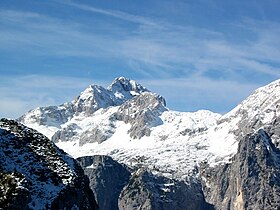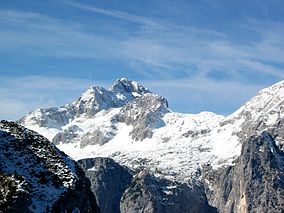Triglav (pronounced [ˈtɾiËÉ¡lau̯]; German: Terglau, Italian: Tricorno) is, with its elevation of 2,864 metres (9,396 ft), the highest mountain in Slovenia and the highest peak of the Julian Alps. The mountain is the pre-eminent symbol of the Slovene Nation. It is the centerpiece of the Triglav National Park, Slovenia's only national park.
Name

Various names have been used for the mountain through history. An old map from 1567 named it Ocra mons, whereas Johann Weikhard von Valvasor named it Krma in the second half of the 17th century. According to the German mountaineer and professor Adolf Gstirner, the name Triglav first appeared in written sources as Terglau in 1452, but the original source has been lost. The next known occurrence of Terglau is cited by Gstirner and is from a court description of the border in 1573. Early forms of the name Triglav also include Terglau in 1612, Terglou in 1664 and Terklou around 1778â€"89. The name is derived from the compound *Tri-golvÑŠ (literally 'three-head'â€"that is, 'three peaks'), which may be understood literally because the mountain has three peaks when viewed from much of Upper Carniola. It is unlikely that the name has any connection to the Slavic deity Triglav. In the local dialect, the name is pronounced TÉ™rgwòu̯ (with a second-syllable accent) in contrast to standard Slovene TrÃglav.
History
The first recorded ascent of Triglav was achieved on 26 August 1778 by Luka KoroÅ¡ec, Matevž Kos, Å tefan RožiÄ and Lovrenc Willomitzer, on the initiative of the industrialist and polymath Sigmund Zois.
Triglav's height was first measured in 1808 by Valentin StaniÄ. The first map its name appeared on was the Zemljovid Slovenske dežele in pokrajin (Map of Slovene Lands and Provinces) by Peter Kosler. He drew it in 1848 and published it in Vienna in 1861.
During World War II, Triglav symbolically captured the primary drive by the Slovene resistance to the Fascist and Nazi armies. The Slovene Partisans wore the Triglav cap from 1942 until after 1944.
Triglav was the highest peak of the now defunct Yugoslavia; it was both countries highest and most prominent peak and, together with the southern Vardar River (now in Republic of Macedonia), was the symbol of Yugoslavian "brotherhood and unity".
Landmarks

Aljaž Tower
At the top of the mountain stands a small metal structure, the Aljaž Tower (Slovene: Aljažev stolp). It acts as a storm shelter and a triangulation point. Along with Triglav, it is also a landmark of Slovenia and a symbol of the Slovenes and Slovenian territorial sovereignty.
The tower's namesake was the priest, mountaineer and patriot Jakob Aljaž. In early 1895, he drew up, with a piece of chalk on the floor of his room in the parish of Dovje, plans for a cylindrical tower with a flag on its top. In April that year he purchased the summit of Triglav for the sum of one Austro-Hungarian gulden. Having done so, he secured himself the right to erect a building on the mountain top. The tower was constructed from iron and zinc coated sheet steel by Anton Belec from Šentvid near Ljubljana. He and four workers brought the parts of the tower to the summit of Triglav and put the tower together in only five hours on 7 August 1895. The opening took place that same day. Aljaž donated the shelter to the Slovene Mountaineering Society.
In the beginning, there were three four-legged chairs, a summit register, a spirit stove, and the image Triglav Panorama by Marko Pernhart in the tower. It was later repainted and renovated several times by Alojz Knafelc and others. In the Communist era, as the highest point of the former Yugoslavia, it was painted red and decorated with a red star. However, it has now more or less been restored to its original appearance. The star was removed shortly before the dissolution of Yugoslavia. On the proclamation of Slovene independence in June 1991, the flag of Slovenia was raised on top of the tower.
StaniÄ Shelter
in 1895, due to lack of space, Aljaž also commissioned the building of StaniÄ Shelter. It is located 55 metres (180 ft) under the top of Triglav and is named after the poet and mountaineer Valentin StaniÄ. The shelter has the dimensions of 2.4×2.2×2 m (7 ft 10 in×7 ft 3 in×6 ft 7 in) and has room for 8 people sitting or 16 standing. Originally it also had a wooden door, banks, a table and a chair. Its significance diminished after the Kredarica Hut was erected in 1896.
Triglav Glacier
The Triglav Glacier (Triglavski ledenik) is located below the summit on the karstified Triglav Plateaux (Triglavski podi), part of the northeastern side of the mountain. Covering over 40 hectares (99 acres) at the end of the 19th century, the glacier had shrunk to 15 hectares (37 acres) by 1946, and after further shrinkage had fallen into two parts by 1992. It now covers an area of only 1â€"3 hectares, depending on the season.
Cultural significance
Folk literature
The Triglav area is the setting of an old Slovene folk tale concerning a hunter seeking a treasure guarded by an enchanted chamois buck named Zlatorog (Goldhorn, after its golden horns).
Arts
The earliest known depiction of Triglav is on the front page of the work Oryctographia Carniolica, written by Belsazar Hacquet. It was a copper engraving made in 1778 by C. Conti after a drawing by Franz Xaver Baraga. Among later visual artists who depicted Triglav, the most well known are Anton Karinger (1829â€"1870) from Ljubljana, Marko Pernhart (1824â€"1871) from Klagenfurt, Valentin Hodnik (1896â€"1935) from Stara Fužina, Edo Deržaj (1904â€"1980) from Ljubljana, and more recently Marjan Zaletel (born 1945), living in Ljubljana.
Among the musical works related to Triglav, a special place is held for the poem Oh, Triglav, My Home (Oj, Triglav, moj dom). It was written in 1894 by the priest and poet Matija ZemljiÄ and quickly became very popular among Slovene mountaineers. In 2007, its first stanza, accompanied by a melody of Jakob Aljaž, became the official anthem of the Mountaineering Association of Slovenia. An instrumental version of the poem, written by Bojan AdamiÄ, is part of the start and end credits of the annual ski jumping broadcasts from Planica.
The first Slovene-language full-length film, recorded in 1931 by Janko Ravnik, was titled In the Kingdom of the Goldhorn (V kraljestvu Zlatoroga) and features an ascent by a group of students to the top of Triglav. The second Slovene full-length film, recorded the following year, was titled The Slopes of Mount Triglav (Triglavske strmine). It was directed by Ferdo Delak and was a romantic story featuring a wedding on the top of Triglav.
Since 1968, Triglav has become a theme of avant-garde artists. The first instance was a manifestation by the art group OHO, called Mount Triglav, which took place in December 1968 at Ljubljana's Congress Square. In 2004, the group IRWIN produced a series of paintings named Like to Like/ Mount Triglav. In 2007, an artistic performance was held atop Mount Triglav by the artists Janez Janša (director), Janez Janša (visual artist) and Janez Janša (performance artist) called Mount Triglav on Mount Triglav.
National symbol
A stylized depiction of Triglav's distinctive shape is the central element of the Slovene coat of arms, and is in turn featured on the flag of Slovenia. Formerly, it was featured on the coat of arms of the Socialist Republic of Slovenia.
The distinctive three-pronged caps worn by Slovene Partisans during World War II were known as triglavkas. A relief map of the mountain is the design on the national side of the Slovene 50 eurocent coin.
The former Slovene president Milan KuÄan once proclaimed that it is a duty of every Slovenian person to climb Triglav at least once in their lifetime
See also
- Triglav Lakes Valley
Notes
References
External links
- Julian Alps: Triglav Hribi.net. Detailed information and images.
- Julian Alps: Triglav. SummitPost.org. Detailed information, maps and images.

Posting Komentar